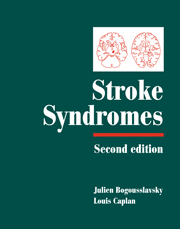Book contents
- Frontmatter
- Contents
- List of contributors
- Preface
- PART I CLINICAL MANIFESTATIONS
- 1 Stroke onset and courses
- 2 Clinical types of transient ischemic attacks
- 3 Hemiparesis and other types of motor weakness
- 4 Sensory abnormality
- 5 Cerebellar ataxia
- 6 Headache: stroke symptoms and signs
- 7 Eye movement abnormalities
- 8 Cerebral visual dysfunction
- 9 Visual symptoms (eye)
- 10 Vestibular syndromes and vertigo
- 11 Auditory disorders in stroke
- 12 Abnormal movements
- 13 Seizures and stroke
- 14 Disturbances of consciousness and sleep–wake functions
- 15 Aphasia and stroke
- 16 Agitation and delirium
- 17 Frontal lobe stroke syndromes
- 18 Memory loss
- 19 Neurobehavioural aspects of deep hemisphere stroke
- 20 Right hemisphere syndromes
- 21 Poststroke dementia
- 22 Disorders of mood behaviour
- 23 Agnosias, apraxias and callosal disconnection syndromes
- 24 Muscle, peripheral nerve and autonomic changes
- 25 Dysarthria
- 26 Dysphagia and aspiration syndromes
- 27 Respiratory dysfunction
- 28 Clinical aspects and correlates of stroke recovery
- PART II VASCULAR TOPOGRAPHIC SYNDROMES
- Index
- Plate section
17 - Frontal lobe stroke syndromes
from PART I - CLINICAL MANIFESTATIONS
Published online by Cambridge University Press: 17 May 2010
- Frontmatter
- Contents
- List of contributors
- Preface
- PART I CLINICAL MANIFESTATIONS
- 1 Stroke onset and courses
- 2 Clinical types of transient ischemic attacks
- 3 Hemiparesis and other types of motor weakness
- 4 Sensory abnormality
- 5 Cerebellar ataxia
- 6 Headache: stroke symptoms and signs
- 7 Eye movement abnormalities
- 8 Cerebral visual dysfunction
- 9 Visual symptoms (eye)
- 10 Vestibular syndromes and vertigo
- 11 Auditory disorders in stroke
- 12 Abnormal movements
- 13 Seizures and stroke
- 14 Disturbances of consciousness and sleep–wake functions
- 15 Aphasia and stroke
- 16 Agitation and delirium
- 17 Frontal lobe stroke syndromes
- 18 Memory loss
- 19 Neurobehavioural aspects of deep hemisphere stroke
- 20 Right hemisphere syndromes
- 21 Poststroke dementia
- 22 Disorders of mood behaviour
- 23 Agnosias, apraxias and callosal disconnection syndromes
- 24 Muscle, peripheral nerve and autonomic changes
- 25 Dysarthria
- 26 Dysphagia and aspiration syndromes
- 27 Respiratory dysfunction
- 28 Clinical aspects and correlates of stroke recovery
- PART II VASCULAR TOPOGRAPHIC SYNDROMES
- Index
- Plate section
Summary
Introduction
Stroke is one of the most common neurological problems faced by neurologists and internists. Frontal lobe strokes produce wide variations of symptoms and outcome, which can be challenging even to experienced clinicians. Presentations range from profound akinesia and mutism to subtle changes in emotional processing and personality. Because of its large size, its dependence on both anterior and middle cerebral arteries, and its mediation of many processes underlying human adaptation, the frontal lobe is a particularly important cerebral region to understand. This chapter addresses both organizational and clinical aspects of the frontal lobe, particularly those signs, symptoms and cerebrovascular lesion patterns that clinicians are likely to encounter. Stroke management has changed dramatically over the past few years, particularly with the FDA approval of intravenous t-PA. The new acute stroke motto is ‘stroke is a brain attack and time is brain’. There are multiple acute stroke therapies, including intravenous/intra-arterial thrombolysis and various neuroprotective agents on the horizon, and these therapies may have a significant impact on subsequent stroke outcomes. There are currently no studies that specifically address functional outcomes after acute stroke with frontal lobe involvement. As frontal stroke syndromes can be quite devastating to the patient and family, we hope future studies will better address these syndromes and whether hyperacute stroke interventions alter their outcome.
Anatomical and organizational features of the frontal lobe
Perhaps the most fundamental feature of the frontal lobe is its division into primary motor, premotor and prefrontal cortical areas. This is based on cytoarchitecture as well as functional distinctions, and is evident on lateral and mesial surfaces of the frontal lobe.
- Type
- Chapter
- Information
- Stroke Syndromes , pp. 232 - 241Publisher: Cambridge University PressPrint publication year: 2001
- 1
- Cited by



